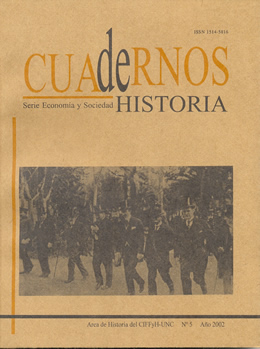Radicals, Alvear and the search for support among railroad workers
DOI:
https://doi.org/10.53872/2422.7544.n5.9906Abstract
With the exception of Paul Goodwin, historians had not noticed that first with Hipólito Yrigoyen and even more so with Marcelo T. de Alvear, the government viewed with sympathy the creation of a strong union that later became the Unión Ferroviaria (UF). In this article I want to explore how and why reciprocal interests developed between that union and the radical leaders. I will not explore the changes in the working conditions of the railwaymen in detail but, I insist, I will focus my attention on the development of the interests that made the union leaders and the radicals cooperate with each other. This type of cooperation is far from unique as it occurred also in other parts of the world, but its existence has long been ignored in Argentina because it does not fit into certain stereotypes.
References
Alonso, Paula, 2000, Between Revolution and the Ballot Box: The Origins of the Argentine Radical Party, Cambridge University Press, Cambridge.
Bak, Joan M., 1998, “Labor Community, and the Making of a Cross-Class Alliance in Brazil: The 1917 Railroad Strikes in Rio Grande do Sul,” Hispanic American Historical Review, 78:2, Mayo, 179-227.
Berquist, Charles, 1986, Labor in Latin America: Comparative Essays on Chile, Argentina, Venezuela, and Colombia, Stanford University Press, Stanford.
Bravo, Mario, 1927, Capitulos de legislación obrera, Imprenta A. García y Cía, Buenos Aires.
Buyán, Marcelino, 1933, Un avanzada obrera: Orígen, desarrollo, luchas y conquistas de La Fraternidad, La Vanguardia, Buenos Aires.
Casaretto, Martín, 1947, Historia del movimiento obrero argentino, II, José Vescovo, Buenos Aires.
Chiti, Juan B. y Agnelli, Francisco, 1937, Cincuentenario de “La Fraternidad”: Fundación, desarrollo, obra, Revashino Hnos., Buenos Aires.
Comisión especial de representantes de empresas y obreros ferroviarios, 1930, Revisión de escalafones, convenios y reglamentos, Guillermo Kraft, Buenos Aires.
Di Tella, Torcuato, “Perón and the Unions: In Search of the Roots”, inédito.
Fernández, Alfredo, 1935-1937, El movimiento obrero en la Argentina, Plus Ultra, Buenos Aires.
Fernández, Manuel F., 1948, La Unión Ferroviaria a través del tiempo: Veinticinco años al servicio de un ideal, 1922-1947, Unión Ferrroviaria, Buenos Aires.
Fraser, Steve, 1991, Labor Will Rule: Sidney Hilman and the Rise of American Labor, Free Press New York.
Goldberg, Heidi, 1979, “Railroad Unionization in Argentina, 1912-1929: The Limitations of Working Class Alliance” , Ph.D. dissertation, Yale University.
Goodwin, Paul B., 1974, Los ferrocarriles británicos y la U.C.R., 1916-1930, Ediciones La Bastilla, Buenos Aires.
Gordillo, Mónica, 1988, El movimiento obrero ferroviario desde el interior del país (1916-1922), Centro Editor de América Latina, Buenos Aires.
Horowitz, Joel, 1985, “Los trabajadores ferroviarios en la Argentina (1920-1943). La formación de una elite obrera”, Desarrollo Económico, 25: 99, Octubre-Diciembre, 421-446.
Horowitz, Joel, 1990, Argentine Unions, the State and the Rise of Perón, 1930-1945, Institute for International Studies, University of California, Berkeley.
Horowitz, Joel, 1995, “Argentina’s Failed General Strike of 1921: A Critical Moment in the Radicals’ Relations with Unions”, Hispanic American Historical Review, 75,1, February, 57-79.
Horowitz, Joel, 1999, “Bosses and Clients: Municipal Employment in the Buenos Aires of the Radicals, 1916-30", Journal of Latin American Studies, 31:3, October, 617-44.
Karush, Matthew B., 1997, “Workers or Citizens: The Construction of Political Identities in Democratic Argentina, Rosario, 1912-1930", Ph.D. dissertation, University of Chicago.
Lozza, Arturo Marcos, 1985, Tiempo de huelgas: Los apasionados relatos del campesino y ferroviario Florindo Moretti sobre aquellas épocas de fundaciones, luchas y serenatas, Editorial Anteo, Buenos Aires.
Luna, Félix. 1978, Ortiz: Reportje a la Argentina opulenta, Editorial Sudamericana, Buenos Aires.
Marotta, Sebastián, 1961, El movimiento sindical argentino: Su genesis y desarrollo, período: 1907-1920, II, Ediciones “Lacio” Buenos Aires.
Molina, Raúl A., 1963 “Presidencia de Marcelo T. de Alvear”, en Academia Nacional de la Historia, Historia argentina contempóranea, I , segunda parte, El Ateneo, Buenos Aires, 271-345.
Palermo, Silvana, 2001, “Railways and the Making of Modern Argentina”, Ph.D. dissertation, State University of New York, Stony Brook.
Rock, David, 1975, Politics in Argentina, , 1890-1930: The Rise and Fall of Radicalism, Cambridge University Press, London.
Rögind, William, 1937, Historia del Ferrocarril Sud, Establecimientos Gráfico Argentino, Buenos Aires.
Sabato, Hilda,1998, La política en las calles. Entre el voto y la moviliación, Buenos Aires, 1862-1880, Editorial Sudamericana, Buenos Aires.
Juan Suriano, 1991, “Estado y conflicto social: El caso de la huelga de maquinistas ferroviarios de 1912”, Boletín del Instituto de Historia Argentina y Americana ‘Dr.
E.Ravignani’, Tercera serie, 4, 2do. Semestre, 91-115.
Thompson, Ruth, a, “The Engineer Drivers’ and Firemen’s Strike of 1912,” inédito. Thompson, Ruth, b, “The Making of the Confraternidad Ferroviaria,” inédito.
Thompson, Ruth, 1992, “Trade Union Organisations: Some Forgotten Aspects,” in Essays in Argentine Labour History, 1870-1930, ed. by Jeremy Adelman, Macmillan, London.
Wright, Winthrop R., 1974, British-owned Railways in Argentina: Their Effects on the Growth of Economic Nationalism, 1854-1948, University of Texas Press, Austin.
Downloads
Published
Issue
Section
License
Copyright (c) 2014 Cuadernos de historia. Serie Economía y Sociedad

This work is licensed under a Creative Commons Attribution 4.0 International License.
Authors publishing in this journal accept the following terms:
a. The author maintains their copyrights and grants this journal the publication of the first original version of their work that is subject to the Creative Commons Attribution License 4.0. This license agreement allows:
Sharing — copy and redistribution of the published material by any means and formats
Reusing — remix, change, and creation of new material from the published work for any purpose, including commercial use.
b. Authors may enter other non-exclusive license agreements of distribution of the version of the published work (i.e. uploading the material on an institutional virtual archive or republishing it on a monographic volume) as long as they attribute the publication of the original version to this journal.
c. It is allowed and recommended that authors publicize their work on the Internet (i.e. on institutional virtual archives or on their personal or professional websites) after their work has been published in this journal.




